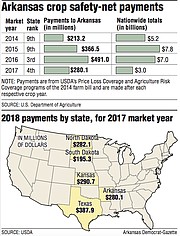Arkansas farmers have received $280 million in federal "safety net" payments for losses that occurred in 2017 because of low market prices, the fourth-highest payout in the nation.
The payments compare with $491 million for 2016 market losses, especially in rice; $366 million for 2015 market losses in rice, corn and soybeans; and $213 million in 2014, also for market losses primarily in rice, corn and soybeans.
Administered through two programs of the U.S. Department of Agriculture's Farm Service Agency, payments made each year are for the previous market year.
The safety-net programs are part of the 2014 farm bill passed by Congress. It replaced years of "direct" payments to farmers, regardless of market conditions or crop yields, and required farmers to select one of the two programs for each of their subsidy-eligible crops. A new farm bill, passed by Congress late last year to run through 2023, retained the two programs:
• The Price Loss Coverage program makes payments when market-year average prices are below certain reference prices determined by the USDA.
• The Agricultural Risk Coverage program creates payment rates for each county in the nation by comparing historical average crop yields and prices in the county with actual yields and prices in the county.
Of the $280 million paid out in Arkansas, all but about $20 million was through the Price Loss Coverage program.
Better prices for rice are the main reason for the drop in payments of $491 million to $280 million, said H. Scott Stiles, an agriculture economist with the University of Arkansas System's Agriculture Division but who is based at Arkansas State University.
Almost all of the rice acreage in Arkansas -- the nation's biggest rice producer, at more than 1 million acres a year -- is enrolled in the Price Loss Coverage program, Stiles noted.
When the rice market dropped in 2016, with big yields on high acreage, farmers ultimately got $1.83 per bushel in Price Loss Coverage payments, Stiles said. When the market for rice rebounded somewhat the next year, in part because of tighter supplies and reduced acreage, they received $1.05 per bushel in Price Loss Coverage payments.
"That difference of 78 cents a bushel is driving the reduction in the [Price Loss Coverage] program payments," Stiles said. "We've been in a pattern of being strong one year and being down the next, so that's why you see the wild swings in Arkansas."
Nationally, the programs paid out a combined $3 billion for the 2017 market year, compared with $7 billion for 2016, $7.8 billion for 2015, and $5.2 billion for 2014, according to the USDA. The reduction generally reflects an increase in commodity prices, following five consecutive years in which average farm income declined, according to USDA figures.
The Price Loss Coverage and Agricultural Risk Coverage payments for long- and medium-grain rice dropped from about $815 million for the 2016 market year to $486 million.
Other crops in Arkansas eligible for the subsidies are soybeans, wheat, corn, oats, sorghum, barley and peanuts. Farmers in 69 of the state's 75 counties received payments. Cotton is covered under a separate program.
The safety-net programs for market losses don't include what farmers can receive for damage caused by floods, drought and other disasters.
They also are separate from payments this winter to farmers who saw prices for their commodities drop -- especially for soybeans -- because of President Donald Trump's trade war with China. Those numbers aren't yet available, in part because the 35-day partial shutdown of the federal government interrupted farmers' ability to file their applications for the tariff-relief package and delayed those payments.
"It's not as strong a safety net as we need, for circumstances that are beyond our control, like we saw all of last year," Randy Veach, a Mississippi County farmer and president of Arkansas Farm Bureau, said in projecting higher safety-net payouts for 2018 crops. He noted that average farm income has dropped by 50 percent since 2013.
"Weather in 2018 was just horrible, with some extreme heat early and then, especially late, when we couldn't get out into the fields for harvest," Veach said. "Soybeans damaged in the field by too much rain led to big discounts at the grain elevators. We had the intervention of our government into the market -- and I'm not saying that as a bad thing, because it might work out in the end -- but it did cause our market for soybeans and other crops to drop."
The safety-net payments don't make a farmer whole and are important to the nation, Veach said.
"The ag industry is part of national security," he said. "Without a doubt, we produce more food, fiber and shelter than any nation on Earth. We feed, clothe and shelter not just our nation but other nations around the globe. Agriculture is directly responsible for one in six jobs in Arkansas, and it's important that our government, through taxpayers, help support farmers."
About 30,500 payments were made in Arkansas through the two programs for the 2017 market year, compared with 36,450 for 2016. How many payments a farmer receives depends on the number of eligible crops enrolled in the program.
Farmers under the old farm bill had to choose between the two programs for the five-year duration of the law. The new law gives them a little more flexibility. They'll have to decide between Agricultural Risk Coverage and Price Loss Coverage for 2019 and 2020 crops. For 2021 crops and after, they'll make an annual selection.
The new farm bill also makes specialty crops, such as fruits and vegetables, eligible for Price Loss Coverage or Agricultural Risk Coverage coverage.
SundayMonday Business on 03/10/2019
